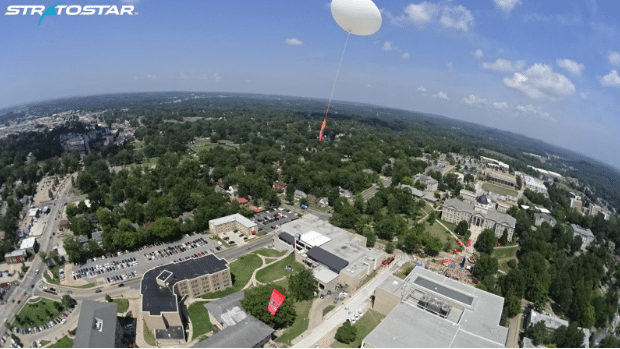This summer teachers and students across the United States had the opportunity to witness an eclipse of the Sun. If you were lucky enough to be in the path of totality, which stretched from Salem, Oregon to Charleston, South Carolina, then you had the chance to witness one of the most awe-inspiring natural events known to mankind: a total solar eclipse.

The eclipse as seen from one of two StratoStar high-altitude balloons launched from Houck Stadium on August 21, 2017, timed to reach maximum altitude—over 100,00 feet above Earth—just as the eclipse was taking place over Southeast Missouri State University.
As you can imagine, we here at StratoStar weren’t going to miss it. On August 21st, 2017, we recorded aerial footage of the eclipse from over 100,000 feet above Missouri using two of our high-altitude scientific balloons and GoPro Hero 5 video cameras.
Stratostar was collaborating with Southeast Missouri State University to launch high-altitude balloons and capture photos and videos of the eclipse from an altitude of over 100,000 feet in the air. The mission was a huge success. We captured photos and videos of the eclipse from angles and elevations that have never been seen before.

One of StratoStar’s scientific balloons captured this photo of its sister balloon on its way to capture images of the eclipse from the stratosphere, pictured here above the beautiful Southeast Missouri State University campus.
“Once the balloons are released there’s little to no control over exactly where they’ll go.”
According to Jason Krueger, founder of StratoStar, the jetstream and other prevailing weather patterns are the deciding factor. So calculating the exact time to launch required some precise calculations.
“Too much helium and the balloon will burst earlier than desired, whereas not enough helium means the balloon could travel too far, making payload recovery more difficult,” says Krueger.
“And then there’s the weight of the payload boxes, which house student science experiments. We’ve got to calculate the right amount of lift based on the total weight of the flight system.”
Take a look at some of the amazing images we recorded during our mission to capture the eclipse from above. As you can see in the photo below, the moon’s circular shadow is carving a path of total darkness across parts of Missouri.

One of StratoStar’s scientific balloons captured this photo of the eclipse from over 100,000 feet above Missouri.
In this series of photos, you can see the moment our high-altitude balloon burst, which occurred just as the Moon was passing in front of the Sun.
If you haven’t already watched our video, Chasing the Eclipse, you can see it on Facebook or watch it on YouTube.
Big thank you’s go out to everyone who helped with the search and recovery. It’s always great to meet new people and share our passion for high-altitude science with them.
Special thanks to Kaci Heinz from Space Center Houston and all of the wonderful people at Southeast Missouri State University.






